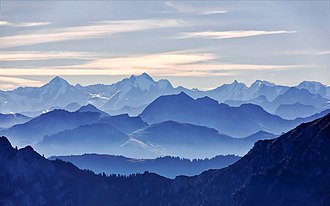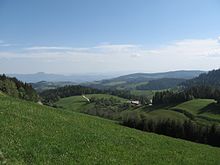Mountain range
![]()
This article describes the general geographic concept of mountains; for other meanings, see Mountains (disambiguation).
A mountain range is a complex landscape form of the earth, which is characterized by a mass elevation of the earth's surface clearly protruding from the lowlands as well as terrain forms with different slope inclinations, corresponding expositions (angle of incidence of the sunlight, sunny and shady slopes) as well as diverse relief forms.
Basically, a distinction is made between low mountain ranges (rather rounded peaks, open rock only locally, vegetation form differs only gradually from the lowlands) and high mountain ranges (rather rugged peaks, landscape-shaping rock regions, clearly different vegetation forms compared to the surrounding countryside). A definition based on altitude above sea level depends on regional conditions and is therefore not generally valid. Only in older literature can definitions be found that (also) refer to absolute altitude, for example Norbert Krebs and Alfred Philippson 1500 m (for temperate zone mountains). All mountain types belong to the large landforms that form the macrorelief of the Earth.
37.4% of the earth's land surface lies between 1000 and 2000 m above sea level. Mountains are generally distributed from the polar regions to the tropics. The largest mountains on earth are located in the west of the American double continent, in a continuous mountain arc from southwest to central and south Asia to east Asia, in the Mediterranean region and in east Africa.
The formation of mountains - especially due to the displacement of continental plates - occurred in several epochs in the history of the Earth. Each uplift was followed by a phase of erosion up to extensive levelling. Therefore, the mountain ranges that exist today are primarily a consequence of the most recent phase of formation (Alpidic orogeny). Today's (trunk) mountains, which are attributed to older phases, are strictly speaking the result of a renewed uplift, while the unfolding of the high mountains is still partly not complete.
Virtually all of the Earth's mountains were heavily affected by glaciation during the Pleistocene, so the shape of today's mountains is not due to current climatic conditions. Most mountains, and especially the highest among them, also belong to the Earth's tectonically active zones, and uplift is in some cases greater than rates of removal by erosion and denudation.

Rising from the rather rounded, forested low mountain ranges to the most rugged summit regions of the high mountains (mountain view in Nepal)

The largest mountains on Earth: High Asia with the Himalayas at the southern edge of the Tibetan Plateau (grey); part of the Alpidic uplift, which continues towards Europe; in the northeast the separate South Siberian Mountains
Definition and usage
In common parlance, a mountain range is understood to be
- a group of more or less connected mountains as a mountain range or group of mountains
- a mountainous geographical region, a mountainous country
The word "mountain", on the other hand, has a regionally different perception. Elevations such as the Wilseder Berg, at only 169 m above sea level the highest point in the vicinity of Lüneburg, would at best be called a hill in Alpine countries. In general, "mountain" denotes a single peak or a ridge line. "Hügelland" stands for accumulations of small elevations, without an exact delimitation being possible.
Geology, on the other hand, refers to the "mountain base" in its definition: the mountain base or rump (when exposed) is the basement. In the younger mountains it is overlain by the overburden, and in the process is often pushed to great depths (as far down as the Moho). "Mountains" in the latter terms already stands in the geological sense as a "rock unit".
In the English language, there is no term for mountains in the sense of a coherent entity: "Mountains" means "mountains" and is thus merely the plural without any concrete attribution.
Highlands - such as Tibet - are not considered mountains because they have little elevation change. In contrast, some areas on a cliff may be considered mountainous despite having little elevation above sea level.
See the EU definition of mountainous areas: classification according to altitude and steepness.
Geology and mountain building
→ Main article: Mountain formation
In geology, the term mountains or the technical term orogen is used inconsistently. In the American Press/Siever: General Geology (2008), the term orogen is used for young mountains and contrasted with the terms shield, platform, sedimentary basin, crustal extension zones (areas in which the youngest deformation is due to crustal extension), and large volcanic provinces.
In the sense of geology, mountains are primarily elongated bands of deformed rocks that are formed by lithospheric plates pressing against each other (mainly in the vicinity of two plates, but also far away from them by stress transfer) and thus lead to the formation of mountains mainly by overthrusting of sheared rock covers. The greater the pressure effect of plate tectonics and the longer it lasts, the higher the uplift of the Earth's crust and the more parallel strands bulge to the right and left of the central, oldest area. While these intermontane intermediate ranges often consist of compact, poorly articulated plateaus (such as the highlands of Tibet, the Altiplano, or the Columbia Plateau), the younger marginal ranges are usually more strikingly rugged and clearly demarcate themselves from the surrounding lowlands.
The formation of the mountains is accompanied by changes in the rocks. Typical rocks for mountains are metamorphic rocks such as gneiss, as well as igneous rocks such as granite, both rocks have a high silicon content typical for the continental crust.
Mountain shapes
Mountains can also be classified according to their general geomorphological or orographic shape. Measures for this are the relief energy, dominance and height of the individual peaks and mountain groups:
- Ridge mountains: Linear mountain ranges with pronounced, branched ridge lines (Taunus, Salzburg Slate Alps).
- Kammgebirge: Linear mountain ranges with a single main ridge line (Krkonoše, Bachergebirge in the Alps).
- Chain mountains: Linear mountain ranges with several parallel ridges (Alps, other alpine mountains).
- Kuppengebirge: Mountains with irregularly rising peaks that rise from a common mountain base (Frankenwald, peripheral mountains of the Alps)
- Massif mountains: Clearly closed elevations in relation to the surrounding countryside, which, however, do not show any recognizable main direction of individual mountain ranges (Harz, French Massif Central)
- Plateaugebirge: Mountains where only the base is preserved and there is no ridge line and little summit formation (Swabian Alb)
- rump mountains: mountains of which only the rump remains, elevated hills (Bohemian Massif)
- Shield: An old mountain hull as a tableland, which is no longer recognizable as such (Baltic Shield)
- Inselberg: mountain range that rises abruptly from a plain (Sugar Loaf, Uluru, mid-Swedish inselbergs)
With regard to their formation and internal structure (rock profile), a distinction is made:
- Tectonic mountain range formed by tectonics, i.e. slow movements of rock masses:
- Ceiling mountains are formed by strong lateral thrust without any possibility of escape (Alps)
- Folded mountains due to plastic deformation of rock layers in geosynclinal seas (Swiss Jura)
- Fracture fold mountains, also fracture clod mountains due to folding and fracturing of the blankets (Rocky Mountains)
- by pure fracture tectonics the following forms are formed:
- Block Mountain
- Fracture Mountains
- Schollen Mountains
- Volcanic mountains, which are formed by the "coalescence" of several eruption foci (Vogelsberg, Auvergne), or from a single hard effusive mass (Adamello group).
In a large mountain range, different mountain types can also mix. The complex history of folding and overthrusting of the Alps shows numerous small forms of other mountain types.

High mountains of the Alps: Texelgruppe near Meran

Foothills of the Alps with low mountain range character: Bacher Mountains near Maribor
Questions and Answers
Q: What is a mountain range?
A: A mountain range is a geographic area with many mountains.
Q: What is a system of mountain ranges?
A: A system of mountain ranges includes geological features that are in the same region as a mountain range.
Q: What do mountain ranges usually include?
A: Mountain ranges usually include highlands or mountain passes and valleys.
Q: Do individual mountains in the same range always have the same geology or petrology?
A: No, individual mountains in the same range do not always have the same geology or petrology.
Q: What are some examples of orogenic expressions and terrains found in mountain ranges?
A: Examples of orogenic expressions and terrains found in mountain ranges include thrust sheets, uplifted blocks, fold mountains, and volcanic landforms.
Q: Why do mountain ranges have a variety of rock types?
A: Mountain ranges have a variety of rock types because individual mountains may be a mix of different orogenic expressions and terrains.
Q: What are other names for mountain range?
A: Other names for mountain range include mountain chain and mountain belt.
Search within the encyclopedia